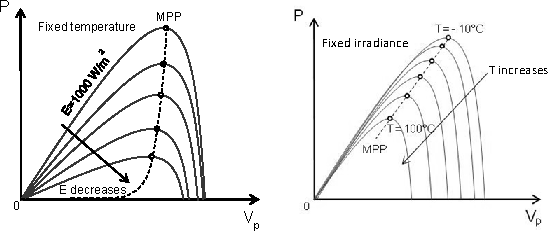2.4. Maximum electric power extraction [AST 08b] [PRO 97] [GER 02]
From an experimental point of view, photovoltaic cells (PV) show many variations in their electric power, depending on weather conditions. Moreover, when they are connected to a load, the voltage applied to their terminals is not controlled and the power transferred to the load rarely corresponds to the maximum power supplied by the PV generator. The MPP (maximum power point) constantly varies, due to variance of the outside conditions, such as cell irradiance and temperature (Figure 2.37)
Figure 2.37. Variation of the MPP with the irradiance and temperature

In order to extract the maximum available power from a photovoltaic generator and supply it to any load, it would be interesting to use a switching converter associated with a maximum power point tracking (MPPT) method as an interface between the generator and the load. This method has been used, at least since 1968. These types of controllers are particularly adapted to pilot a non-linear source and force the generator to work at its MPP. It thus causes a global improvement of the efficiency of the electric conversion system, on the condition that the efficiency of the conversion stage is also high enough.
When a photovoltaic source is connected directly to a load, the operating point is determined by taking the intersection of the electric characteristics ...
Get Electricity Production from Renewables Energies now with the O’Reilly learning platform.
O’Reilly members experience books, live events, courses curated by job role, and more from O’Reilly and nearly 200 top publishers.

